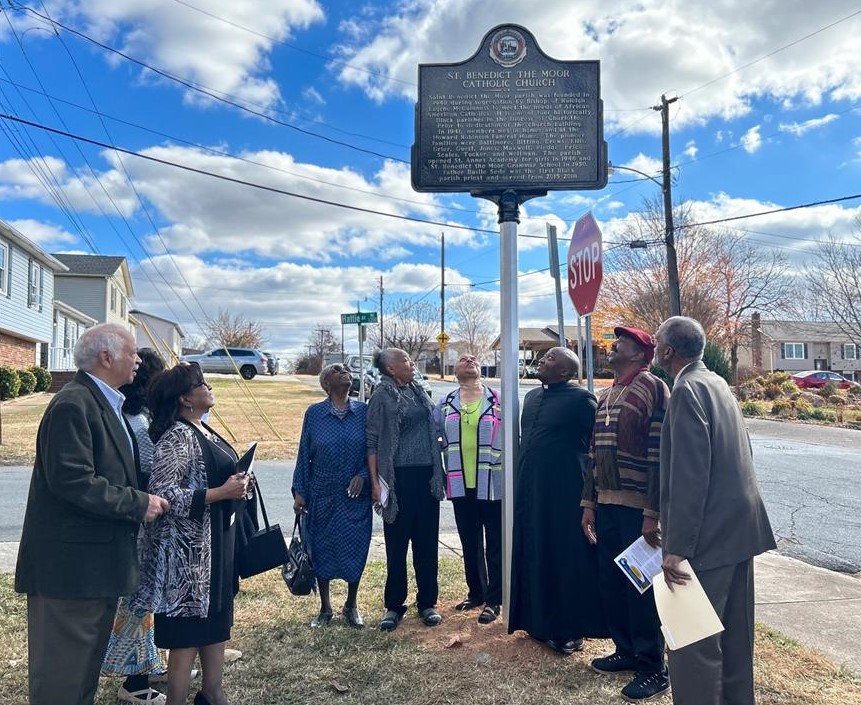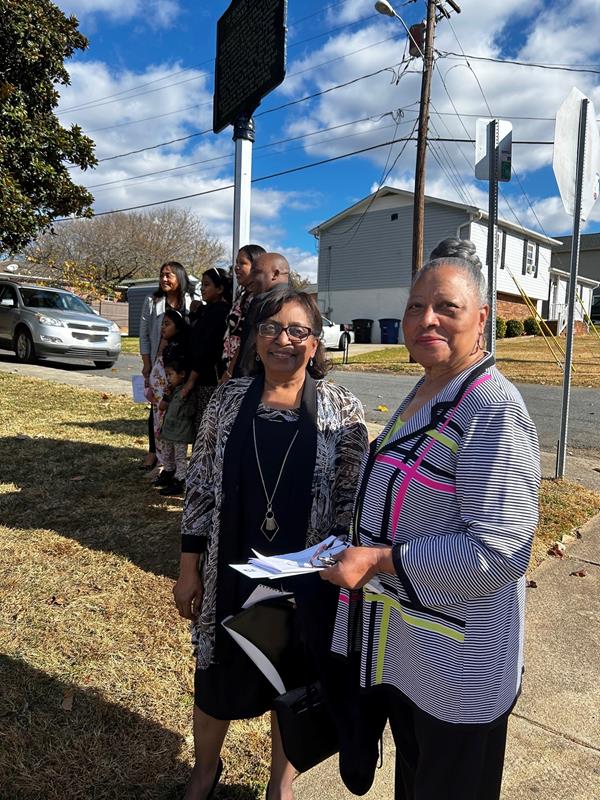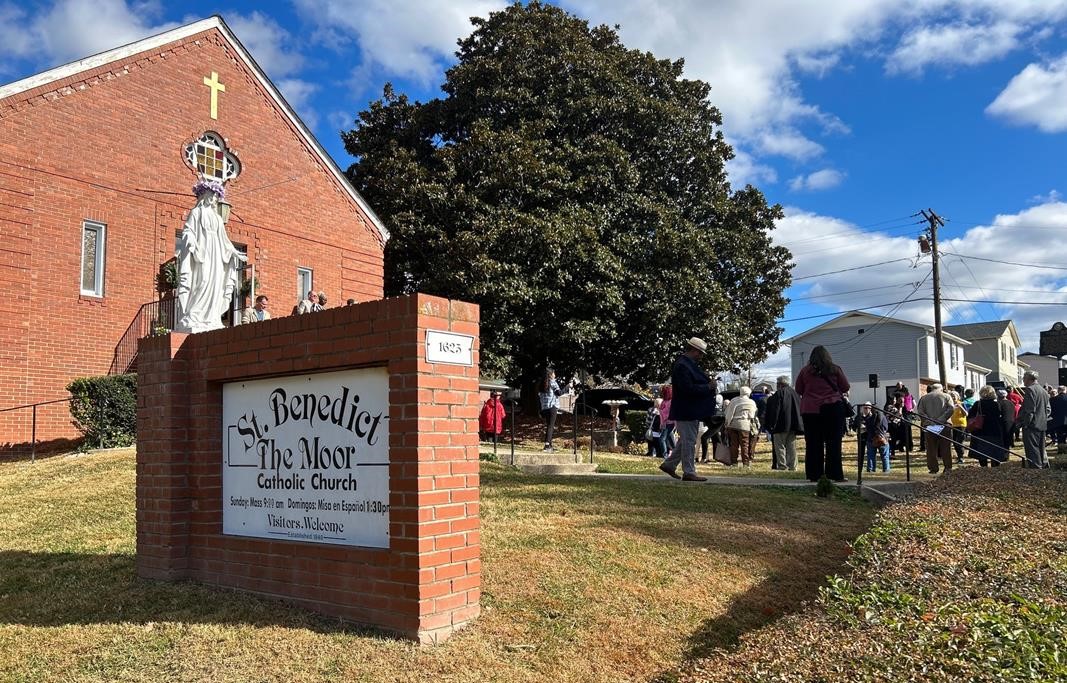'A commitment to faith’
 Parishioners of St. Benedict the Moor admire the parish's new historic landmark with their pastor, Father Melchesideck Yumo.WINSTON-SALEM — One of four historically African American churches in the Diocese of Charlotte was honored with a historic marker Saturday.
Parishioners of St. Benedict the Moor admire the parish's new historic landmark with their pastor, Father Melchesideck Yumo.WINSTON-SALEM — One of four historically African American churches in the Diocese of Charlotte was honored with a historic marker Saturday.
St. Benedict the Moor Church received the historic marker from the Forsyth County Historic Resources Commission Nov. 18. It joins a select number of Catholic churches in North Carolina recognized by a state or local government for their historic importance.
During a special ceremony Nov. 18 to unveil the marker, St. Benedict's pastor, Father Melchesideck Yumo, and parishioners gathered inside the church to give thanks to God for the special occasion.
After the invocation and singing of the hymn “Come By Here,” Chenita Johnson from the Forsyth County Historic Resources Commission gave the opening remarks.
“Our markers help our residents to remember and to learn about important parts of our collective history, and this includes the specific places and history of those places which should never be forgotten,” Johnson said. “Today we celebrate St. Benedict the Moor Catholic Church, which was established in 1940 to serve Winston-Salem's African American Catholics who were not especially welcomed in the local Catholic churches at the time.”
Until the 1950s and 1960s, harsh "Jim Crow" laws mandated segregation in public spaces, schools, transportation and other places throughout the South including North Carolina – preventing Catholic Church leaders from offering integrated worship. Churches like St. Benedict the Moor and its accompanying parochial school were built to meet the needs of Black Catholics and accommodate the growing Catholic population during and after World War II.
Harold Holmes, chairperson of St. Benedict the Moor's parish council, also spoke during the ceremony.
“The founding families in the 1940s would be extremely proud to learn of the resiliency and commitment to faith that has brought us this wonderful moment of recognition,” Holmes said.
St. Benedict the Moor, a Franciscan friar, is the patron saint of African Americans. Franciscan priests ministered at the parish from its founding in 1940 until 1966. Since then, the parish has been staffed by Jesuit priests, diocesan clergy and, most recently, priests from Cameroon, Holmes noted.
Parishioner and St. Benedict School alumnus Cedric Russell also spoke, along with Gloria Wilson and Dr. Betty Alexander, members of the St. Benedict History  Parishioners Lois Jones and Dr. Betty Alexander, chairperson of the St. Benedict History Committee, enjoy the historic moment.Committee. Wilson noted the contributions of the parish's committee members, who went through digital and print records, including parish bulletins, letters from priests, and letters written by the religious sisters who ran St. Benedict the Moor School. She also commended Alexander’s role as chairperson and her keen ability to keep the group focused and on task.
Parishioners Lois Jones and Dr. Betty Alexander, chairperson of the St. Benedict History Committee, enjoy the historic moment.Committee. Wilson noted the contributions of the parish's committee members, who went through digital and print records, including parish bulletins, letters from priests, and letters written by the religious sisters who ran St. Benedict the Moor School. She also commended Alexander’s role as chairperson and her keen ability to keep the group focused and on task.
“St. Benedict the Moor is an historic place of worship that has served as a pillar for Black spirituality, culture and a community center for decades in Winston-Salem’s East Winston community,” said Rosheene Adams, director of the Diocese of Charlotte’s African American Affairs Ministry, in comments before the event. “Black churches have stood at the center of the African American experience and are a living testament to the achievements and resiliency of generations in the face of turbulence and a racialized, unbalanced society. What an honor to be bestowed this special honor from the city.”
After the ceremony, the congregation processed outside to the veiled historic marker. Father Yumo had the honor of unveiling the marker, which reads:
“Saint Benedict the Moor Parish was founded in 1940 during segregation by Bishop of Raleigh Eugene McGuinness to meet the needs of African American Catholics. It is one of four historically Black parishes in the Diocese of Charlotte. Prior to dedication of the church building in 1941, members met in homes and at the Howard Robinson Funeral Home. The pioneer families were Baltimore, Bitting, Crews, Ellis, Grier, Guest, Jones, Maxwell, Pledge, Price, Scales, Tucker, and Wellman. The parish opened St. Anne’s Academy for girls in 1946 and St. Benedict the Moor Grammar School in 1950. Father Basil Sede was the first Black parish priest and served from 2015-2018.”
In addition to St. Benedict the Moor, there are three other historically Black parishes in the Diocese of Charlotte. They are Our Lady of Consolation Parish in Charlotte, St. Mary's Parish in Greensboro, and St. Helen Mission in Spencer Mountain.
It is one of only a few Catholic churches or sites in the diocese to be honored with a historic marker from a local or state government. Sites within the diocese that have North Carolina state historic markers include: Old St. Joseph Church in Mount Holly (one of the oldest Catholic churches in the state, built in 1843), and Belmont Abbey College (founded by Benedictine monks in 1876).
—Annie Ferguson



